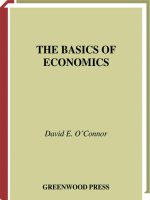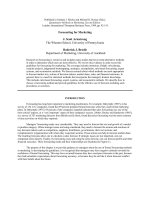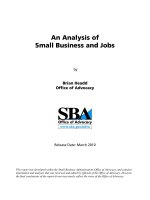Customer Reviews Elements of Investing_1 pot
Bạn đang xem bản rút gọn của tài liệu. Xem và tải ngay bản đầy đủ của tài liệu tại đây (244.01 KB, 18 trang )
xvii
INTRODUCTION
In 100 years of study and experience,* here are the
Elements of Investing we wish we’d always known.
Experience may well be the best teacher, but the tuition
is very high. Our objective is to provide individual
investors—including our delightful grandchildren—the
basic principles for a lifetime of fi nancial success in saving
and investing, all in 176 pages of straight talk that can be
read in just two hours. There are many good books about
investing. (Indeed, we’ve even written a few ourselves.) But
most investing books run to 400 pages or more and go into
complex details that tend to overwhelm normal people.
*
52 for Burt and 48 for Charley.
flast.indd xviiflast.indd xvii 11/3/09 9:40:47 AM11/3/09 9:40:47 AM
xviii
Introduction
If you’re like most people, you have neither the patience
nor the interest to plow through that much detail. You
want to get the main things right. Still, having unbiased
information about fi nancial decision making and avoid-
ing costly investing errors is critically important.
That ’ s why we present the most important les-
sons in this easy-to-read, jargon - free little book. If you
happen to be familiar with William Strunk Jr. and
E. B. White’s classic book, The Elements of Style , you will
recognize one of the original sources of inspiration for
this book — and why we are so brief. If you are unfamil-
iar with Strunk and White, don ’ t worry. All you need to
know is that they whittled down the art of powerful writ-
ing to a few basic rules of usage and composition. In less
than 92 pages, they shared everything about writing that
truly mattered; brevity and precision became instant vir-
tues. Strunk and White’s wafer - thin classic has chugged
along for decades. No doubt it will outlive us all.
We now dare state our goal on the equally important
topic of investing. How surprising to us that everything
of importance on such a heady topic can be reduced to
rules you can count on one hand. Yes, investing can be
that simple if your brain remains unclouded with taxing
complexities. These rules will truly make a difference .
flast.indd xviiiflast.indd xviii 11/3/09 9:40:47 AM11/3/09 9:40:47 AM
xix
Introduction
Our promise: Reading this book will be the best time
you could spend to put yourself on the right path to long -
term fi nancial security. Then, over your lifetime, you can
pick this book up again to scan its lessons and remind
yourself what is elemental if you want to turn a loser ’ s
game into one you can really win.
flast.indd xixflast.indd xix 11/3/09 9:40:47 AM11/3/09 9:40:47 AM
xx
flast.indd xxflast.indd xx 11/3/09 9:40:47 AM11/3/09 9:40:47 AM
THE
ELEMENTS
OF
INVESTING
flast.indd xxiflast.indd xxi 11/3/09 9:40:47 AM11/3/09 9:40:47 AM
flast.indd xxiiflast.indd xxii 11/3/09 9:40:47 AM11/3/09 9:40:47 AM
1
IT ALL STARTS
WITH SAVING
This is a short, straight-talk book about investing. Our
goal is to enhance your fi nancial security by helping you
make better investment decisions and putting you on a
path toward a lifetime of fi nancial success and, particu-
larly, a comfortable and secure retirement.
Don’t let anyone tell you that investing is too complex
for regular people. We want to show you that everybody
can make sound fi nancial decisions. But it doesn’t matter
whether you make a return of 2 percent, 5 percent, or
even 10 percent on your investments if you have nothing
to invest.
So it all starts with saving.
c01.indd 1c01.indd 1 10/31/09 1:34:46 PM10/31/09 1:34:46 PM
2
It doesn ’ t matter whether you make a
return of 2 percent, 5 percent, or even 10
percent on your investments if you have
nothing to invest.
The Elements of Investing
c01.indd 2c01.indd 2 10/31/09 1:34:46 PM10/31/09 1:34:46 PM
3
I
SAVE
S ave. The amount of capital you start with is not nearly
as important as organizing your life to save regularly and
to start as early as possible. As the sign in one bank read:
Little by little you can safely stock up a small
reserve here, but not until you start.
The fast way to affl uence is simple: Reduce your
expenses well below your income — and Shazam! — you
c01.indd 3c01.indd 3 10/31/09 1:34:46 PM10/31/09 1:34:46 PM
4
The Elements of Investing
are affl uent because your income exceeds your outgo.
You have “ more ” — more than enough. It makes no dif-
ference whether you are a recent college graduate or a
multimillionaire. We ’ ve all heard stories of the school-
teacher who lived modestly, enjoyed life, and left an
estate worth over $1 million — real affl uence after a life
of careful spending. And we know one important truth:
She was a saver.
But it can also go the other way. A man with an annual
income of more than $10 million — true story — kept
running out of money, so he kept going back to the trust-
ees of his family ’ s huge trusts for more. Why? Because
he had such an expensive lifestyle — private plane, sev-
eral large homes, frequent purchases of paintings, lavish
entertaining, and on and on. And this man was miserably
unhappy.
In David Copperfi eld, Charles Dickens ’ s character
Wilkins Micawber pronounced a now - famous law:
Annual income twenty pounds, annual expen-
diture nineteen pounds nineteen and six, result
happiness. Annual income twenty pounds,
annual expenditure twenty pounds ought and
six, result misery.
c01.indd 4c01.indd 4 10/31/09 1:34:46 PM10/31/09 1:34:46 PM
5
Save
Saving is good for us — for two reasons. One reason for
saving is to prevent having serious regrets later on. As the
poet John Greenleaf Whittier wrote: “ Of all sad words of
tongue and pen, the saddest are ‘ It might have been.’ ” *
“ I should have ” and “ I wish I had ” are two more of his-
tory ’ s saddest sentences.
Another reason for saving is quite positive: Most of us
enjoy the extra comfort and the feeling of accomplishment
that comes with both the process of saving and with the
results — having more freedom of choice both now and in
the future.
No regrets in the future is important, or will be, to all
of us. No regrets in the present is important, too. Being
a sensible saver is good for you, but deprivation is not.
So don ’ t try to save too much. You ’ re looking for ways
to save that you can use over and over again by making
these new ways your new good habits.
†
The real purpose of saving is to empower you to keep
your priorities — not to make you sacrifi ce. Your goal in
saving is not to “ squeeze orange juice from a turnip ” or to
*
This line is from a poem entitled “Maud Muller,” written in 1856.
†
Or as Malcolm Gladwell suggests in Blink, you might try to get taller.
Being six feet tall adds over $5,000 a year to your income because our
society prefers taller people—so they enjoy better-paying careers.
c01.indd 5c01.indd 5 10/31/09 1:34:46 PM10/31/09 1:34:46 PM
6
The Elements of Investing
make you feel deprived. Not at all! Your goal is to enable
you to feel better and better about your life and the way
you are living it by making your own best - for - you choices.
Savings can give you an opportunity to take advantage of
attractive future opportunities that are important to you.
Saving also puts you on the road to a secure retirement.
Think of saving as a way to get you more of what you
really want, need, and enjoy. Let saving be your helpful
friend.
FIRST DO NO HARM
The fi rst step in saving is to stop dis saving — spending more
than you earn, especially by running up balances on your
credit cards. There are few, if any, absolute rules in saving
and investing, but here ’ s ours: Never, never, never take on
credit card debt. This rule comes as close as any to being an
inviolable commandment. Scott Adams, the creator of the
Dilbert comic strip, calls credit cards “ the crack cocaine of
the fi nancial world. They start out as a no - fee way to get
instant gratifi cation, but the next thing you know, you ’ re
freebasing shoes at Nordstrom. ”
Credit card debt is great — but not for you (or any
other individual). Credit card debt is great for the lenders,
c01.indd 6c01.indd 6 10/31/09 1:34:46 PM10/31/09 1:34:46 PM
7
Save
and only the lenders. Credit cards are a wonderful con-
venience, but for every good thing there are limits. The
limit on credit cards is not your announced “ credit limit. ”
The only sensible limit on credit card debt is zero.
Credit card debt is seductive. It ’ s all too easy to ease
onto the slippery slope — and slide down into overwhelm-
ing debts. You never — well, almost never — get asked to
pay off your debt. The bank will “ graciously ” allow you
to make low monthly payments. Easy. Far too easy! Your
obligations continue to accumulate and accumulate until
you get The Letter, saying you have borrowed too much,
your interest rate is being increased, and you are required
to switch, somehow, from money going to you to money
going from you to the bank. You are not just in debt, you
are in trouble. If you don ’ t do what the bank now says
you must do, legal action will be taken. Be advised! Never,
never, never use credit card debt.
START SAVING EARLY: TIME IS MONEY
The secret of getting rich slowly but surely is the mira-
cle of compound interest. Albert Einstein is said to have
described compound interest as the most powerful force
in the universe. The concept simply involves earning a
c01.indd 7c01.indd 7 10/31/09 1:34:46 PM10/31/09 1:34:46 PM
8
The Elements of Investing
return not only on your original savings but also on the
accumulated interest that you have earned on your past
investment of your savings.
The secret of getting rich slowly, but surely,
is the miracle of compound interest.
Why is compounding so powerful? Let ’ s use the
U.S. stock market as an example. Stocks have rewarded
investors with an average return close to 10 percent a
year over the past 100 years. Of course, returns do vary
from year to year, sometimes by a lot, but to illustrate
the concept, suppose they return exactly 10 percent
each year. If you started with a $100 investment, your
account would be worth $110 at the end of the fi rst
year — the original $100 plus the $10 that you earned.
By leaving the $10 earned in the fi rst year reinvested,
you start year two with $110 and earn $11, leaving your
stake at the end of the second year at $121. In year
three you earn $12.10 and your account is now worth
$133.10. Carrying the example out, at the end of 10
years you would have almost $260 — $60 more than if
you had earned only $10 per year in “ simple ” interest.
Compounding is powerful!
c01.indd 8c01.indd 8 10/31/09 1:34:46 PM10/31/09 1:34:46 PM
9
Save
THE AMAZING RULE OF 72
Do you know the amazing Rule of 72? If not, learn it
now and remember it forever. It ’ s easy, and it unlocks the
mystery of compounding. Here it is: X ϫ Y ϭ 72. That
is, X (the number of years it takes to double your money)
times Y (the percentage rate of return you earn on your
money) equals . . . 72.
Let ’ s try an example: To double your money in 10
years, what rate of return do you need? The answer:
10 times X ϭ 72, so X ϭ 7.2 percent.
Another way to use the rule is to divide any percentage
return into 72 to fi nd how long it takes to double your
money. Example: At 8 percent, how long does it take to
double your money? Easy: nine years (72 divided by 8 ϭ 9).
Try one more: at 3 percent, how long to double your
money? Answer: 24 years (72 divided by 3 ϭ 24).
Now try it the other way: If someone tells you a par-
ticular investment should double in four years, what rate
of return each year is he promising?
Answer: 18 percent (72 divided by 4 ϭ 18).
For anyone whose attention is attracted by the Rule
of 72, the obvious follow - on is surely compelling: If a
c01.indd 9c01.indd 9 10/31/09 1:34:46 PM10/31/09 1:34:46 PM
10
The Elements of Investing
10 percent rate of return will double your money
in 7.2 years, it will double your money again in the next
7.2 years. In less than 15 years (14.4 years to be exact),
you ’ ll have four times your money — and sixteen times your
money in 28.8 years.
So if you ’ re 25 and you skip one glass of wine at a
fancy restaurant today, you might celebrate with your
spouse the benefi t of compounding with a full dinner at
that same restaurant 30 years from now. The power of
compounding is why everyone agrees that saving early in
life and investing is good for you. It is great to have the
powerful forces of time working for you — 24/7.
Time is indeed money, but as George Bernard Shaw
once said, “ Youth is wasted on the young. ” If only we
could all train ourselves at a young age to know what
we know now. When money is left to compound for
long periods, the resulting accumulations can be awe
inspiring. If George Washington had taken just one dol-
lar from his fi rst presidential salary and invested it at 8
percent — the average rate of return on stocks over the past
200 years — his heirs today would have about $8 million.
Think about this every time you see Washington on a
U.S. dollar bill.
c01.indd 10c01.indd 10 10/31/09 1:34:46 PM10/31/09 1:34:46 PM
11
Save
Benjamin Franklin provides us with an actual rather
than a hypothetical case. When Franklin died in 1790, he
left a gift of $5,000 to each of his two favorite cities, Boston
and Philadelphia. He stipulated that the money was to be
invested and could be paid out at two specifi c dates, the
fi rst 100 years and the second 200 years after the date of
the gift. After 100 years, each city was allowed to withdraw
$500,000 for public works projects. After 200 years, in
1991, they received the balance — which had compounded
to approximately $20 million for each city. Franklin ’ s
example teaches all of us, in a dramatic way, the power of
compounding. As Franklin himself liked to describe the
benefi ts of compounding, “ Money makes money. And
the money that money makes, makes money. ”
A modern example involves twin brothers, William
and James, who are now 65 years old. Forty - fi ve years ago,
when William was 20, he started a retirement account,
putting $4,000 in the stock market at the beginning
of each year. After 20 years of contributions, totaling
$80,000, he stopped making new investments but left
the accumulated contributions in his account. The fund
earned 10 percent per year, tax free. The second brother,
James, started his own retirement account at age 40 (just
c01.indd 11c01.indd 11 10/31/09 1:34:46 PM10/31/09 1:34:46 PM
12
The Elements of Investing
after William quit) and continued depositing $4,000
per year for the next 25 years for a total investment of
$100,000. When both brothers reached the age of 65,
which one do you think had the bigger nest egg? The
answer is startling:
William ’ s account was worth almost $2.5 •
million.
James ’ account was worth less than $400,000. •
William ’ s won the race hands down. Despite having
invested less money than James, William ’ s stake was over
$2 million greater. The moral is clear; you can accumulate
much more money by starting earlier and taking greater
advantage of the miracle of compounding.
We could run through dozens of other examples using
actual stock market returns. One investor might start
early but have the worst possible timing, investing at
the peak of the stock market each year. Another investor
starts later but is the world ’ s luckiest investor, buying at
the absolute bottom of the market every year. The fi rst
investor, even though she may have invested less money
and had the worst possible timing, accumulates more
money.
c01.indd 12c01.indd 12 10/31/09 1:34:47 PM10/31/09 1:34:47 PM









